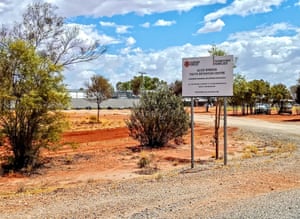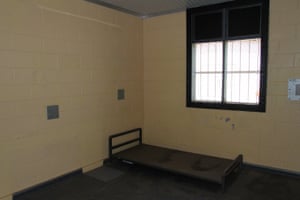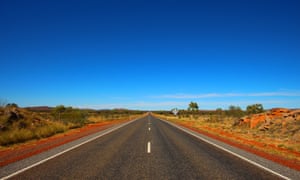I’m told lawyers aren’t meant to have these fierce, protective
feelings for their clients, but the law isn’t meant to torture children
either
Who knew the drive to hell would be so beautiful and that hell would be so small?
It’s not far out of town, but it’s far enough away to be deliberate. We drive out towards the airport – through the gap in the red ranges and down the gum-flanked Stuart Highway. The trunks shift from pale and shimmery to rich red and back again as we pass the racecourse, the billboards and the old Ghan Train by the side of the road.
This is the road to somewhere else. For the folks who’ve come here from the east coast or overseas, this is the road back home. For others it’s the road to adventure.
For everyone it’s the road out of Alice Springs.
The bitumen shifts from black to red and we turn right off the Stuart Highway towards Adelaide.
Or, if you turn off earlier, Uluru.
There’s an in-between place before you get to either. It’s just out of town. It’s where we keep the people we don’t want too close to home. That’s where we’re going.
We go up and over a little bridge and drive across a dry creek bed. The sky is big and low out here.It’s not far out of town, but it’s far enough away to be deliberate. We drive out towards the airport – through the gap in the red ranges and down the gum-flanked Stuart Highway. The trunks shift from pale and shimmery to rich red and back again as we pass the racecourse, the billboards and the old Ghan Train by the side of the road.
This is the road to somewhere else. For the folks who’ve come here from the east coast or overseas, this is the road back home. For others it’s the road to adventure.
For everyone it’s the road out of Alice Springs.
The bitumen shifts from black to red and we turn right off the Stuart Highway towards Adelaide.
Or, if you turn off earlier, Uluru.
There’s an in-between place before you get to either. It’s just out of town. It’s where we keep the people we don’t want too close to home. That’s where we’re going.
We drive past the first in-between place. It’s a lowish cluster of off-white buildings behind a secure fence. It’s where the police used to take people – almost always Aboriginal – who they’d picked up for hitting the grog too hard.
When I first arrived in the Northern Territory, the Alcohol Mandatory Treatment Tribunal was still up and running. It operated on the outdated belief that you can coerce someone out of addiction by forcing them into involuntary residential treatment. You’d be unlikely to find yourself here unless you were an Aboriginal person who’d been drinking in a public place – maybe in the Todd River or somewhere about town. If you were picked up by police three times in two months they could bring you in. You’d be given a mattress on the floor and could wait for more than a week before a lawyer came and saw you.
A man died a few years ago after being picked up by the police for drinking in a public place – not here in Alice Springs but up in Darwin. The police found him sitting under a tree. He had a sick heart. He’d been in hospital just days before. He didn’t want to go with police but they took him in anyway. They put him in a cell and he died there.
That man was picked up under different laws than the ones that used to see folks dumped in this in-between place – but they’re close enough. These laws were written for the same reason as we build these in-between places down long roads, and away from town centres; to pull them “out of circulation” (as the NT attorney general said in 2014).
If we keep driving a little further you can see the prison watchtower on our right. For the most part the prison is a kind of purgatory. It’s another in-between place. Hundreds of the folks in the big house have been charged with offences but have not been found guilty. They spend their summer days sweltering in almost 50C heat without air conditioning and in overcrowded dorms, waiting to tell their story to the judge.
But we’re not going there today. We turn right off the main road and stop at the Alice Springs youth detention centre.

They’ve put demountables up in front of the detention centre; full of security personnel and strong, cold air conditioning. We used to have legal visits inside the detention centre proper, in a room with bars in the door in the middle of a corridor of cells. The air conditioned demountables are much nicer. I worry, though, that we can’t see inside the kid prison from the pristine demountables outside.
We ring the buzzer, sign in and put our car keys and phones in the visitor lockers. I don’t know any of the security guards here today. On other visits I’ve been greeted by a bouncer I recognise from one of the more notorious pubs in town.
They let the first kid on our list through the first gate, then the second gate. The guard tells the boy to sit closest to the door. I say I want the door closed for the interview. The guard asks me to step outside.
"One boy missed his mum so much his call log shows him making over 100 calls in a month, but her phone doesn’t always work and she also has no car to visit"
Outside he tells me where the duress button is. I nod. I say thanks. I know it’s sensible, but it’s hard to imagine using the duress button looking at this kid. He’s all big cheeks and big eyes.
I do most of the talking in my earnest white-lady lawyer way. My client clicks his tongue twice for yes and once for no. He sits side-on to me and looks at the ground. No one knows what to do with this kid. I think he knows that. He doesn’t ask me what’s going to happen next.
We see a few kids today. The next two could not be more different from each other.
One of them is softly spoken and serious. He looks at me when he talks, and looks down at the table as he listens. He tells me when he doesn’t remember things, and describes with visible effort what he can recall. He is thoughtful when I ask him if there’s anything else he wants to tell me, or that he would like me to do for him. He asks me if he can maybe get out of here early. He’s been in for a long time and he’s not been in any trouble since he’s been here. He’d like to finish school. His mum doesn’t have a car so she hasn’t been able to visit. He misses her.
That’s what happens at in-between places. Children fall through the cracks.
One boy in here missed his mum so much that his call log shows him making over 100 calls in a month, but her phone doesn’t always work and she also has no car to visit.
The next kid is bouncing off the walls. He drums his fingers on the table to a beat inside his head. He beams at me when I remind him of my name and tells me he remembers it.
He describes what has happened to him like he’s watching a movie. He speaks quickly and dramatically, punctuating his story with wild gestures.
“And then I went BOOM and hit the ground. BOOM!”
It seems extraordinarily cruel to put a boy like this in a cage.
When we’re done talking, one of the security guards lets us back out through the gates. We sign out of the visitor’s log, collect our car keys and mobile phones and begin the drive back to town.
We’re driving towards the purple mountain ranges this time. It’s beautiful.
I love this drive. I hate this drive. In some ways the drive back home is easier, but it takes a while to push the images of children in concrete boxes out from behind your retina and down your optic nerve and to bury their faces in the shadowy recesses of your brain.
I really care about these kids. I’m told lawyers aren’t meant to have these fierce, protective feelings for their clients, but the law isn’t meant to torture children either – so I figure we’re even.
I get hot behind the eyes.
That’s how one of the young fellas describes what happens to him when he’s locked in his cell and gets angry.
Sometimes it’s hard to get on the same page as these kids. They’re children. I’m an adult. They’re black. I’m white. They’re caged. I’m free. Sometimes they’re hopeless. Sometimes me too. But hot behind the eyes doesn’t need any sort of cross-cultural translation. I know what he means when he tells me that spending days in a cell with nothing to do and no one to talk to makes him hot behind the eyes. It makes me hot behind the eyes to hear him say it.
We pull into the Kmart carpark across the road from Aboriginal Legal Aid. There are some folks sitting on the ground in the shade under the shop awning across the way. It’s 41C. The ground must be burning.
It’s cooler inside. There’s a whiteboard full of children’s names above my desk with dots and dashes to indicate what type of matters they are, important dates, and when each child needs to be seen again. I have a whole cabinet full them – kids’ lives that have been reduced to statements of fact and lists of antecedents.
The drawers are also full of all the things these kids have told me about what’s happened to them. The police officer who kept his hand around the boy’s neck as he yelled that he couldn’t breathe. The child who wanted to kill himself in detention because no one would listen to him. The 11-year-old who played with his plastic transformer in court. The kid who was charged with breaching his bail when he stayed at another family home because there was fighting in his. The one who was arrested at the doctor’s for breaching bail and vomited at the police station.
I tick off the kids we saw today.
There’s one kid on the board who has been up there for almost the whole two years I’ve been in Alice Springs. He has a big red circle around his name. That circle means maybe this kid is slowly being driven mad in that in-between place. It means we should go see him whenever we can. Even if it’s Friday and we want to go to the pub after work. Check he’s OK.
OK.
Surviving. Alive. Not any worse. Not too much worse.
I put the pages of scribbled notes in the youths’ files. I update the spreadsheet. I close the cabinet. We can go home now.
We run into one of the grandmas crossing the road to Kmart. She tells me about a car she heard was stolen. Kids. She tells me that the grandmas are trying to organise visits with the kids in detention. She’s been speaking with local politicians. I saw her at a rally not long back talking about bringing these kids home and keeping them close.
But we don’t let them keep these kids close.
Oftentimes the boys are flown to Don Dale in Darwin because the kid-prison here gets too full. Or they ask to leave because there is nothing to do in prison in Alice Springs. They get up, they shower, sometimes they get to go to school. Sometimes they can do “work party” which means cleaning the cages they’re kept in.
Don Dale is over 1,000km away from their country and family and their place in the world. Mothers without cars can’t get to the in-between place 22km out of town; how are they going to reach their kids when they’re 1,500km away?

In March this year the NT government changed the laws to make it easier to remove children from their families and send them up north. Sometimes they don’t even let their mothers know. They just notify the lawyers and put the kid on a plane that’s already been booked and we barely get enough time to say we object before the child is airborne and heading towards the detention centre that purportedly “shocked the nation.”
We say goodbye to the grandmother in the carpark and get in the car to go home.
I live in the orange house in Old East Side.
The air conditioning is on. There’s mail on the kitchen counter with my name on it. I put my car keys in the dish where the car keys go and sit on the couch in the cool.
This is not an in-between place. Everything about this place screams that it is here and that there are people who belong in it. Three dog leads hang next to our front door. I take one and clip it to Thisbee’s collar. I barely get it on before she starts pulling.
I’ve been listening to a lecture by Anishinaabe Canadian writer Tanya Talaga. I listen to her as we walk through this beautiful, conflicting place and imagine the blood-salt and tear-salt that’s been soaked up by the sand.
Talaga borrows the words of Dr Helen Milroy, Australia’s first Indigenous doctor, to describe a “third space’ between the colonial world and the Aboriginal way. It’s a blank, despairing in-between place where people float in trauma, loss and despair.
"To stand on the edge of genocide is to stand on the edge of the abyss, to be lost forever."
"Think of all the people that you know in your life that love you. They’re like tethers. Cut the ties and you are floating with nothing to ground you."
She means “go” in the forever sense."You have no belonging, so some feel you might as well just go."
That’s what we are doing to these kids.
We cut their ties to the people who love them. We sever them from their belonging, and then we set them adrift 22km out of town.
Sophie Trevitt is a lawyer who has been representing children in Alice Springs over the past two years

No comments:
Post a Comment